Analysis of Injected Electron Beam Propagation in a Planar Crossed-Field Gap
Abstract
1. Introduction
2. Theory of Crossed-Field Stability
3. Crossed-Field Simulation Model
4. Simulation Results
4.1. Effect of Magnetic Field and Current Density
4.2. Effect of Magnetic Field Tilt
5. Discussion
6. Conclusions and Future Works
Author Contributions
Funding
Institutional Review Board Statement
Informed Consent Statement
Data Availability Statement
Conflicts of Interest
References
- Andreev, D.; Kuskov, A.; Schamiloglu, E. Review of the Relativistic Magnetron. Matter Radiat. Extrem. 2019, 4, 067201. [Google Scholar] [CrossRef]
- Nicholls, N.S.; Damon, L.; Scoffield, B.P. Reduction of Noise in High-Power Crossed-Field Amplifiers. Electron. Lett. 1973, 9, 398–399. [Google Scholar] [CrossRef]
- Browning, J.; Fernandez-Gutierrez, S.; Lin, M.C.; Smithe, D.N.; Watrous, J. Phase Control and Fast Start-up of a Magnetron Using Modulation of an Addressable Faceted Cathode. Appl. Phys. Lett. 2014, 104, 233507. [Google Scholar] [CrossRef]
- Lau, Y.Y.; Christenson, P.J.; Chernin, D. Limiting Current in a Crossed-field Gap. Phys. Fluids B 1993, 5, 4486–4489. [Google Scholar] [CrossRef]
- Christenson, P.J.; Lau, Y.Y. Transition to Turbulence in a Crossed-field Gap. Phys. Plasmas 1994, 1, 3725–3727. [Google Scholar] [CrossRef]
- Lopez, M.; Lau, Y.Y.; Luginsland, J.W.; Jordan, D.W.; Gilgenbach, R.M. Limiting Current in a Relativistic Diode under the Condition of Magnetic Insulation. Phys. Plasmas 2003, 10, 4489–4493. [Google Scholar] [CrossRef]
- Christenson, P.J.; Lau, Y.Y. One-Dimensional Modulational Instability in a Crossed-Field Gap. Phys. Rev. Lett. 1996, 76, 3324. [Google Scholar] [CrossRef] [PubMed]
- Chernin, D.P. Computer Simulations of Low Noise States in a High-Power Crossed-Field Amplifier. IEEE Trans. Electron Devices 1996, 43, 2004–2010. [Google Scholar] [CrossRef]
- Gritsunov, A.; Nikitenko, O. Probable Sources of a Noise in Crossed-Field Devices II. Generating Tubes. In Proceedings of the 4th IEEE International Conference on Vacuum Electronics, Seoul, Korea, 28–30 May 2003; pp. 248–249. [Google Scholar]
- Riyopoulos, S.A. Feedback-Induced Noise in Crossed Field Devices. IEEE Trans. Plasma Sci. 1992, 20, 360–369. [Google Scholar] [CrossRef]
- Garner, A.L.; Lau, Y.Y.; Chernin, D. Collapse of Cycloidal Electron Flows Induced by Misalignments in a Magnetically Insulated Diode. Phys. Plasmas 1998, 5, 2447–2453. [Google Scholar] [CrossRef][Green Version]
- Christenson, P.J.; Chernin, D.P.; Garner, A.L.; Lau, Y.Y. Resistive Destabilization of Cycloidal Electron Flow and Universality of (Near-) Brillouin Flow in a Crossed-field Gap. Phys. Plasmas 1996, 3, 4455–4462. [Google Scholar] [CrossRef]
- Kaup, D.J.; Thomas, G.E. Chaotic Instabilities and Density Profiles in a Crossed-Field Electron Vacuum Device. In Proceedings of the Intense Microwave Pulses VII, Aerosense 2000, Orlando, FL, USA, 24–28 April 2000; International Society for Optics and Photonics: Bellingham, WA, USA, 2000; Volume 4031, pp. 54–64. [Google Scholar]
- Kurkin, S.A.; Badarin, A.A.; Koronovskii, A.A.; Frolov, N.S.; Hramov, A.E. Modeling Instabilities in Relativistic Electronic Beams in the CST Particle Studio Environment. Math. Models Comput. Simul. 2018, 10, 59–68. [Google Scholar] [CrossRef]
- Wadhwa, R.; Misra, V. Some Considerations for Reduction of Noise and Instability Improvement in High-Power Crossed-Field Devices. IEEE Trans. Electron Devices 1969, 16, 977–985. [Google Scholar] [CrossRef]
- Birdsall, C.K. Electron Dynamics of Diode Regions; Elsevier: Amsterdam, The Netherlands, 1966; ISBN 0-323-16241-X. [Google Scholar]
- Hull, A.W. The Effect of a Uniform Magnetic Field on the Motion of Electrons Between Coaxial Cylinders. Phys. Rev. 1921, 18, 31. [Google Scholar] [CrossRef]
- Neculaes, V.B.; Jones, M.C.; Gilgenbach, R.M.; Lau, Y.Y.; Luginsland, J.W.; Hoff, B.W.; White, W.M.; Jordan, N.; Pengvanich, P.; Hidaka, Y. Magnetic Priming Effects on Noise, Startup, and Mode Competition in Magnetrons. IEEE Trans. Plasma Sci. 2005, 33, 94–102. [Google Scholar] [CrossRef]
- Sisodia, M.L.; Wadhwa, R.P. Noise Reduction in Crossed-Field Guns by Cathode Tilt. Proc. IEEE 1968, 56, 94–95. [Google Scholar] [CrossRef]
- Kino, G.S.; Taylor, N.J. The Design and Performance of a Magnetron-Injection Gun. IRE Trans. Electron Devices 1962, 9, 1–11. [Google Scholar] [CrossRef]
- Darr, A.M.; Garner, A.L. A Coordinate System Invariant Formulation for Space-Charge Limited Current in Vacuum. Appl. Phys. Lett. 2019, 115, 054101. [Google Scholar] [CrossRef]
- Harsha, N.S.; Garner, A.L. Applying Conformal Mapping to Derive Analytical Solutions of Space-Charge-Limited Current Density for Various Geometries. IEEE Trans. Electron Devices 2020, 1–7. [Google Scholar] [CrossRef]
- Jones, M.C.; Neculaes, V.B.; White, W.; Lau, Y.Y.; Gilgenbach, R.M. Simulation of Rapid Startup in Microwave Magnetrons with Azimuthally Varying Axial Magnetic Fields. Appl. Phys. Lett. 2004, 84, 1016–1018. [Google Scholar] [CrossRef]
- Neculaes, V.B.; Jones, M.C.; Gilgenbach, R.M.; Lau, Y.Y.; Luginsland, J.W.; Hoff, B.W.; White, W.M.; Jordan, N.M.; Pengvanich, P.; Hidaka, Y. Magnetic Perturbation Effects on Noise and Startup in DC-Operating Oven Magnetrons. IEEE Trans. Electron Devices 2005, 52, 864–871. [Google Scholar] [CrossRef]
- Child, C. Discharge from Hot CaO. Phys. Rev. (Ser. I) 1911, 32, 492. [Google Scholar] [CrossRef]
- Langmuir, I. The Effect of Space Charge and Residual Gases on Thermionic Currents in High Vacuum. Phys. Rev. 1913, 2, 450. [Google Scholar] [CrossRef]
- CP Studio. CST Studio Suite; CP Studio: Darmstadt, Germany, 2019. [Google Scholar]
- Humphries, S., Jr. Numerical Modeling of Space-Charge-Limited Charged-Particle Emission on a Conformal Triangular Mesh. J. Comput. Phys. 1996, 125, 488–497. [Google Scholar] [CrossRef]
- Guerrera, S.A.; Akinwande, A.I. Nanofabrication of Arrays of Silicon Field Emitters with Vertical Silicon Nanowire Current Limiters and Self-Aligned Gates. Nanotechnology 2016, 27, 295302. [Google Scholar] [CrossRef] [PubMed]
- Guerrera, S.A.; Akinwande, A.I. Silicon Field Emitter Arrays with Current Densities Exceeding 100 A/Cm 2 at Gate Voltages below 75 V. IEEE Electron Device Lett. 2015, 37, 96–99. [Google Scholar] [CrossRef]
- Black, J.R.; Boyd, J.A.; Dombrowski, G.; Needle, J.; Peterson, W.; Ruthberg, S.; Welch, H.W.; Brewer, G.R.; Hok, G.; Batten, H.W. Theoretical Study, Design, and Construction of CW Magnetrons for Frequency Modulation: Quarterly Progress Report No. 2; University of Michigan: Ann Arbor, MI, USA, 1950. [Google Scholar]
- Chernin, D.; Jassem, A.; Lau, Y.Y. Thermal Electron Flow in a Planar Crossed-Field Diode. IEEE Trans. Plasma Sci. 2020, 48, 3109–3114. [Google Scholar] [CrossRef]
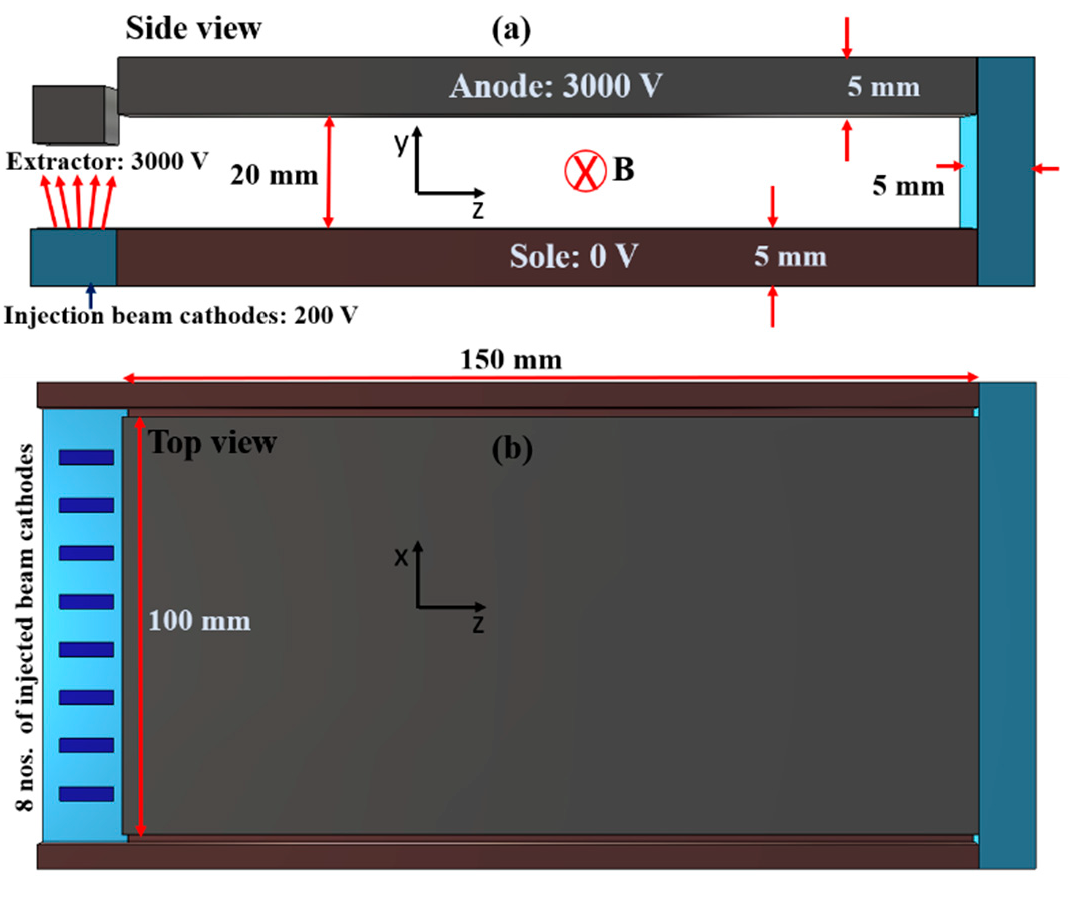

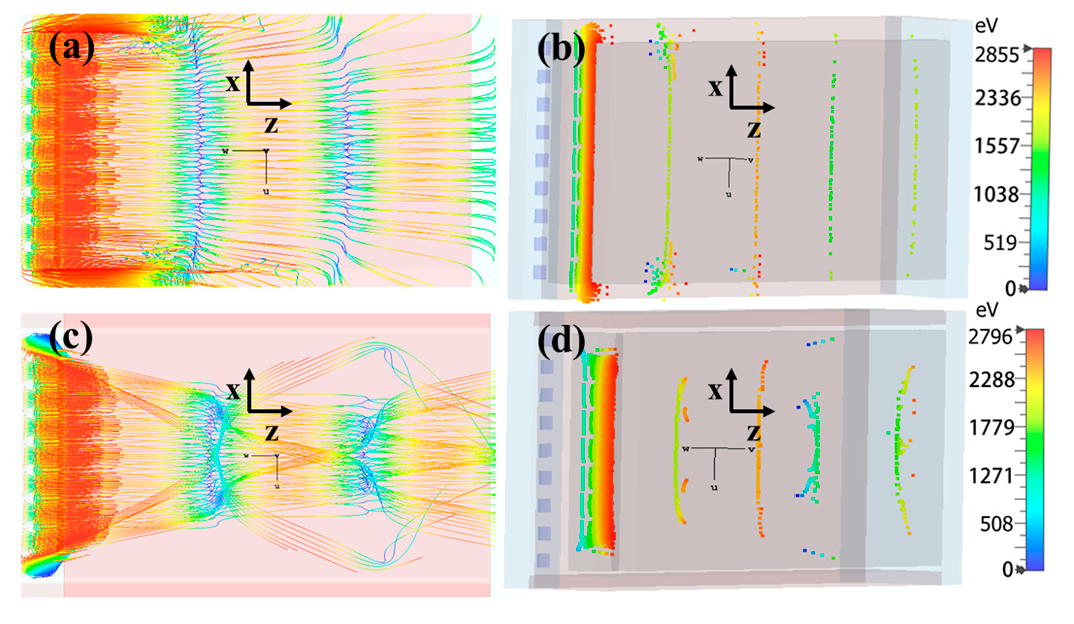
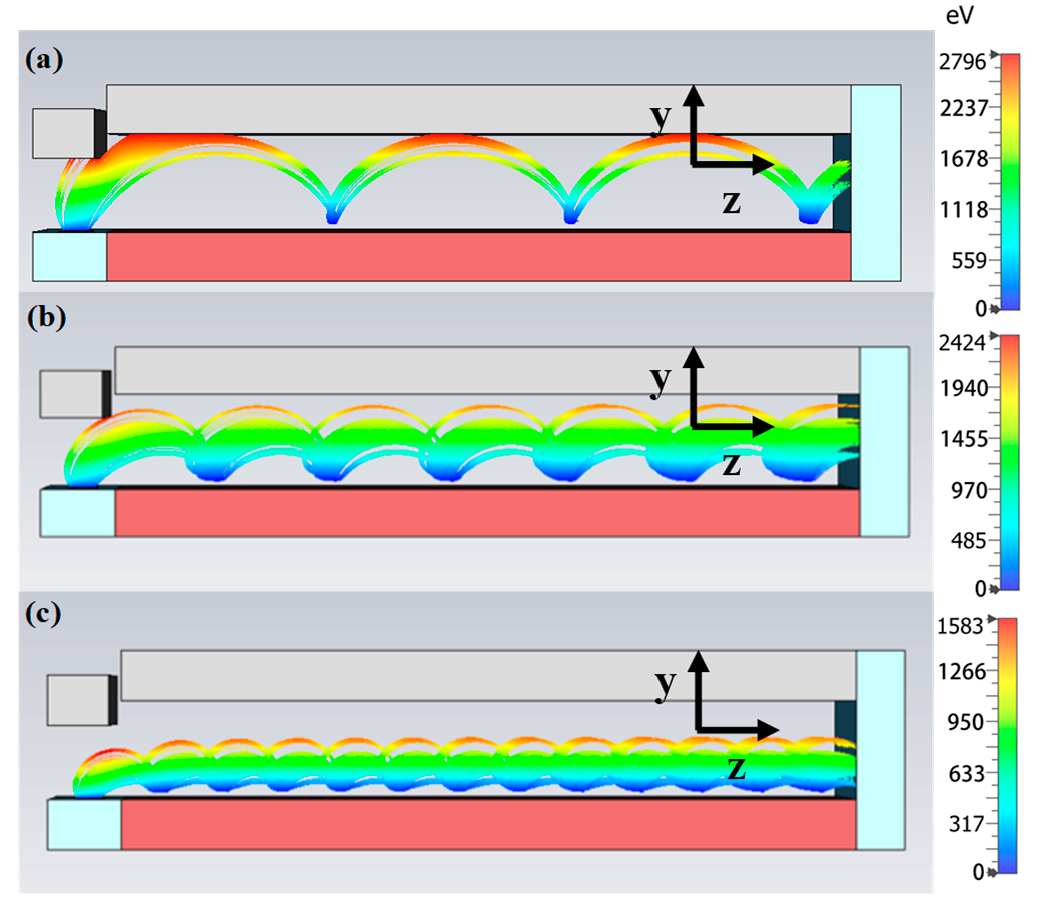

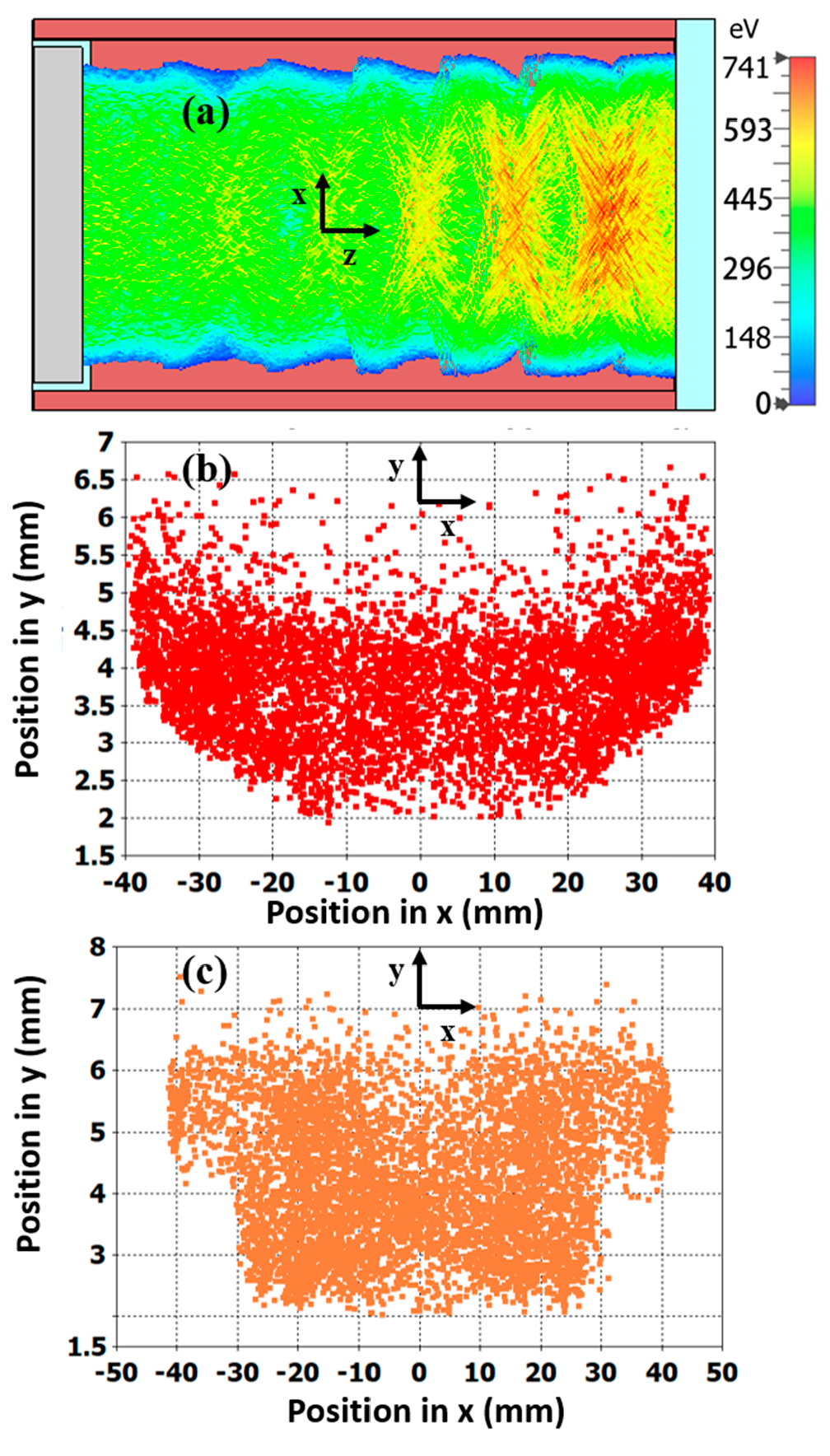
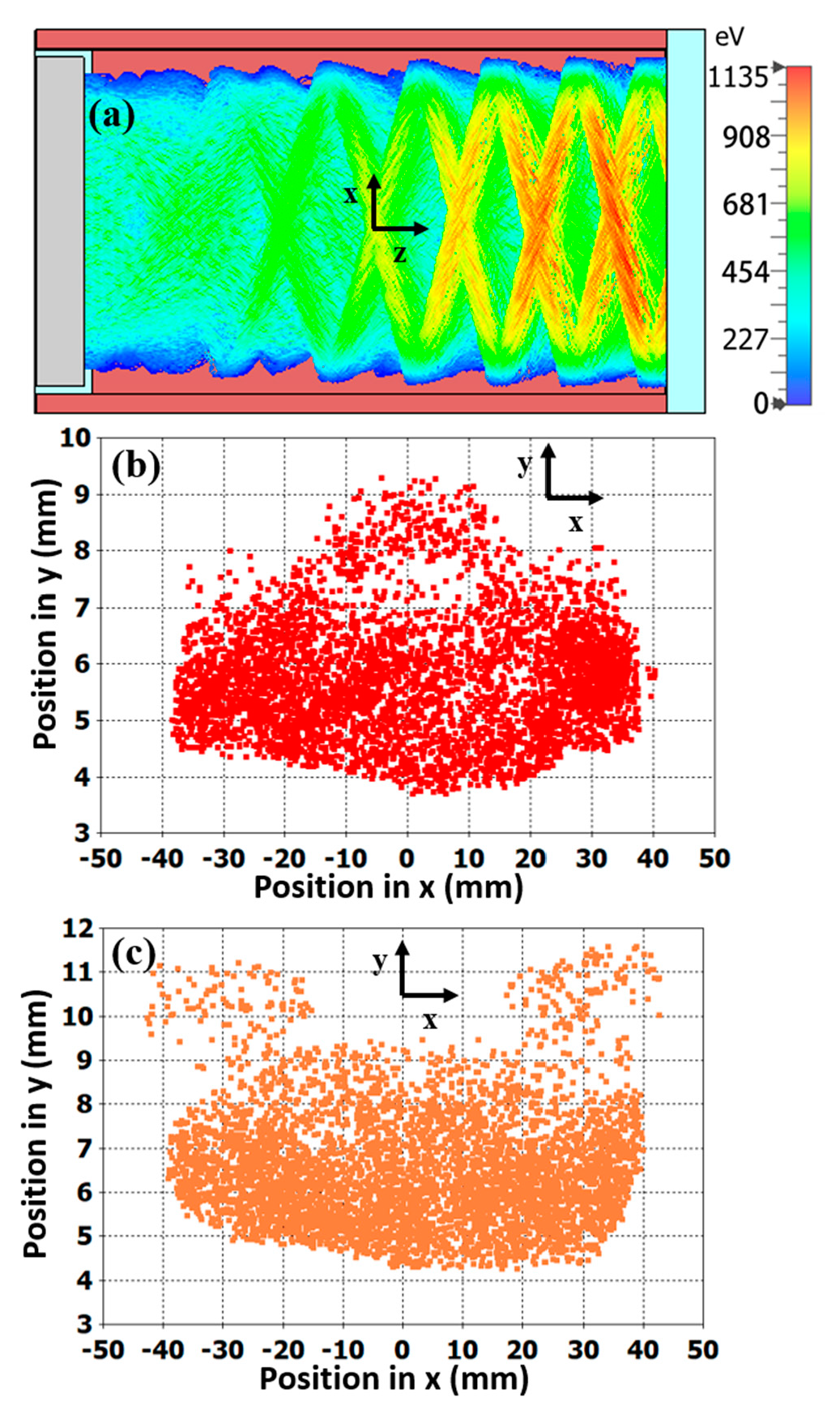

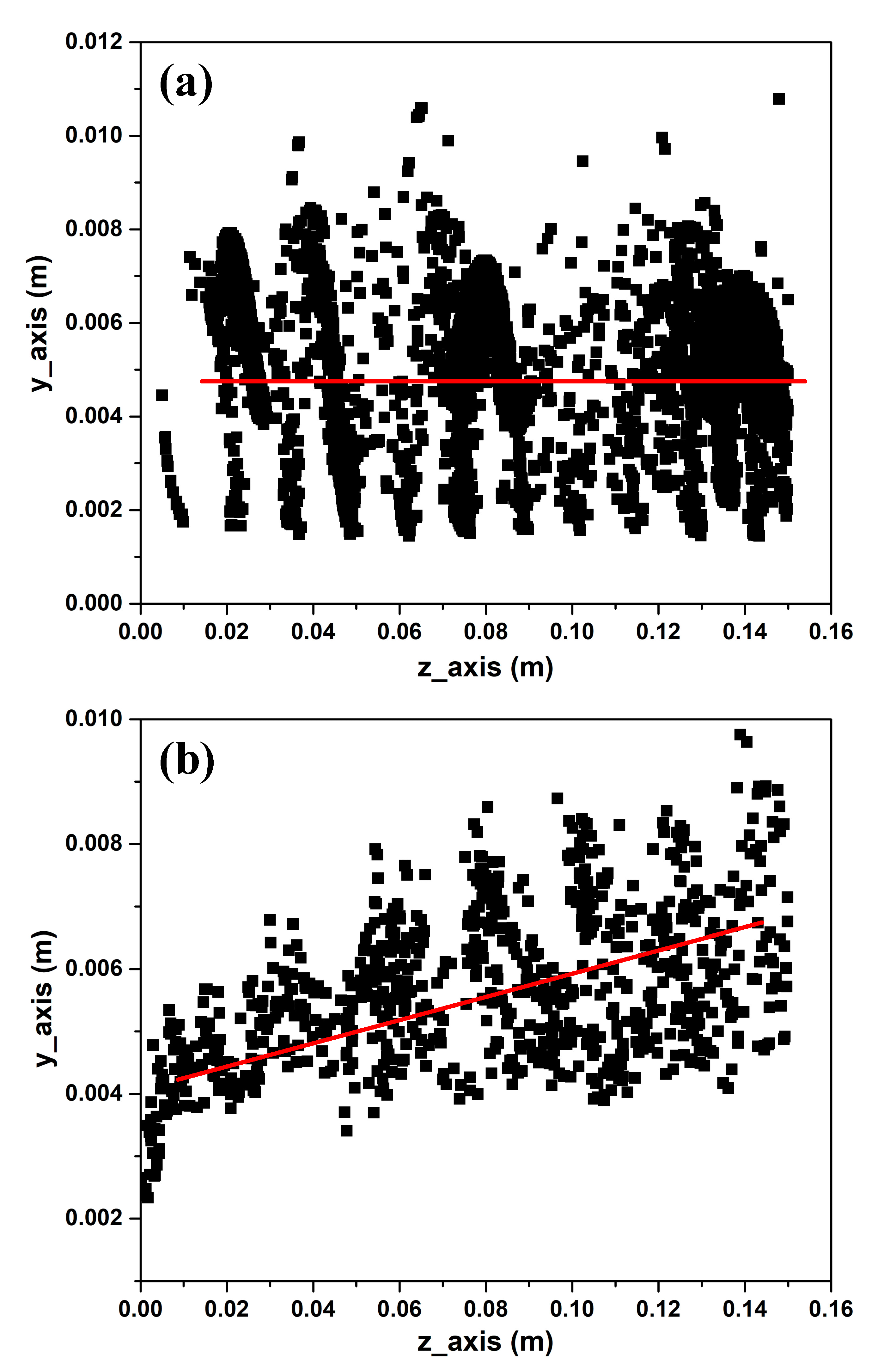
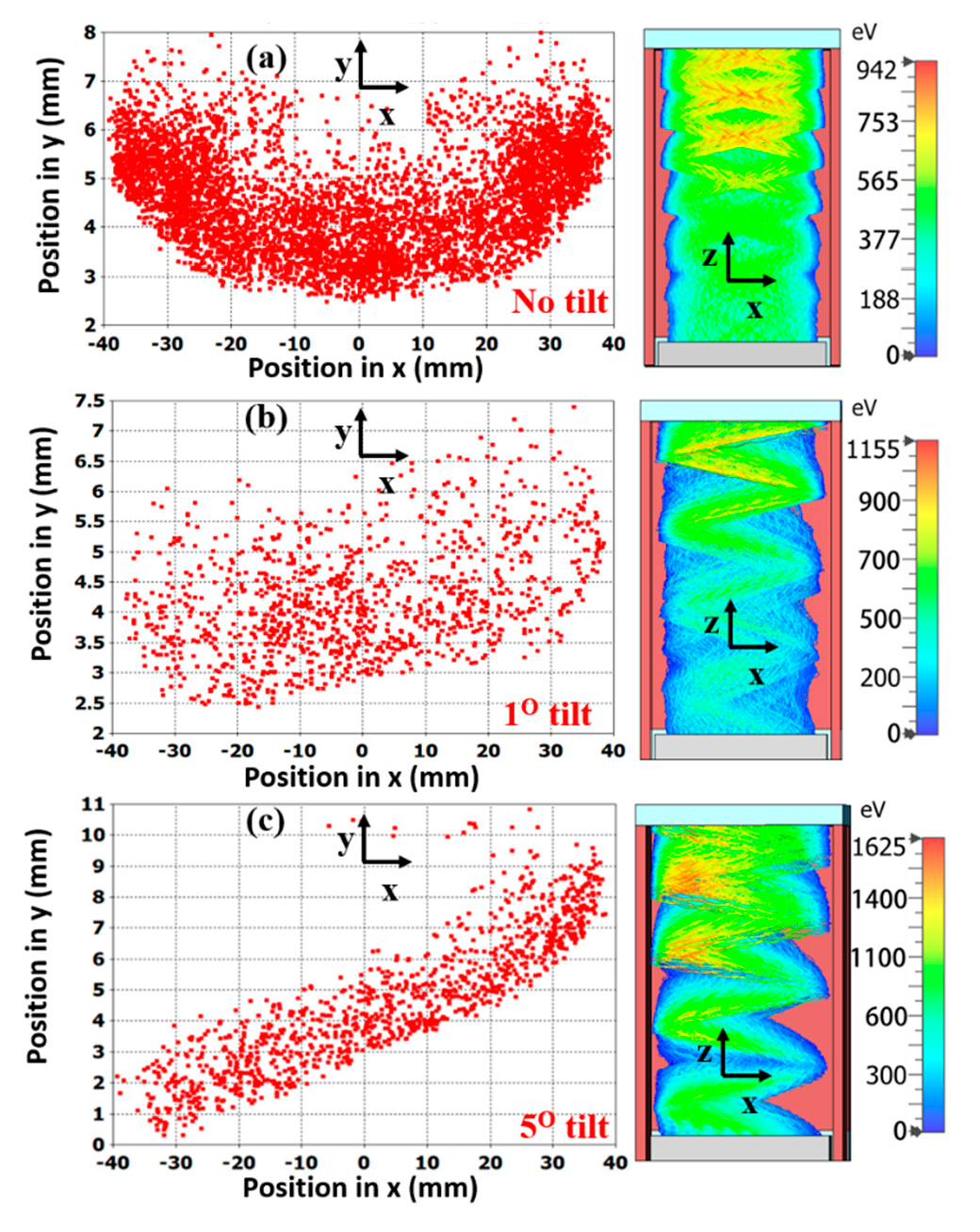
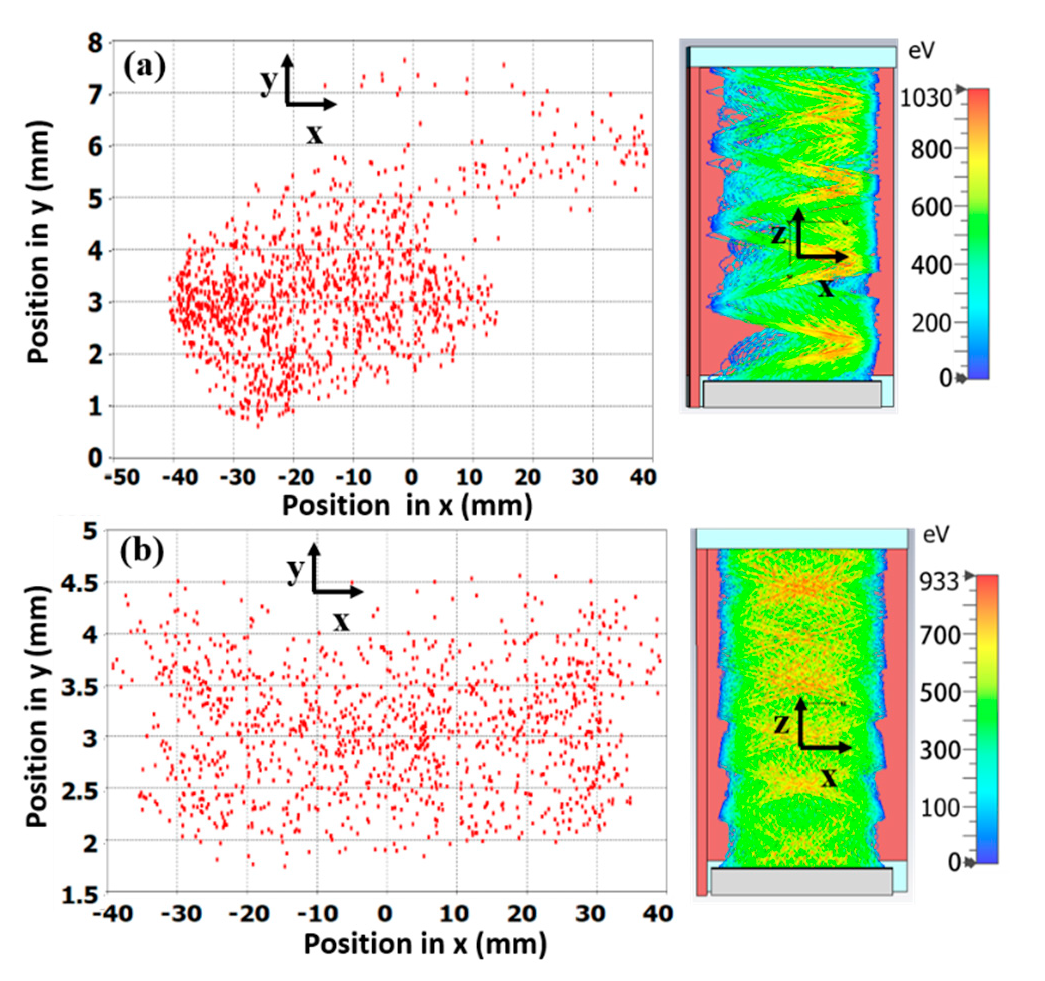
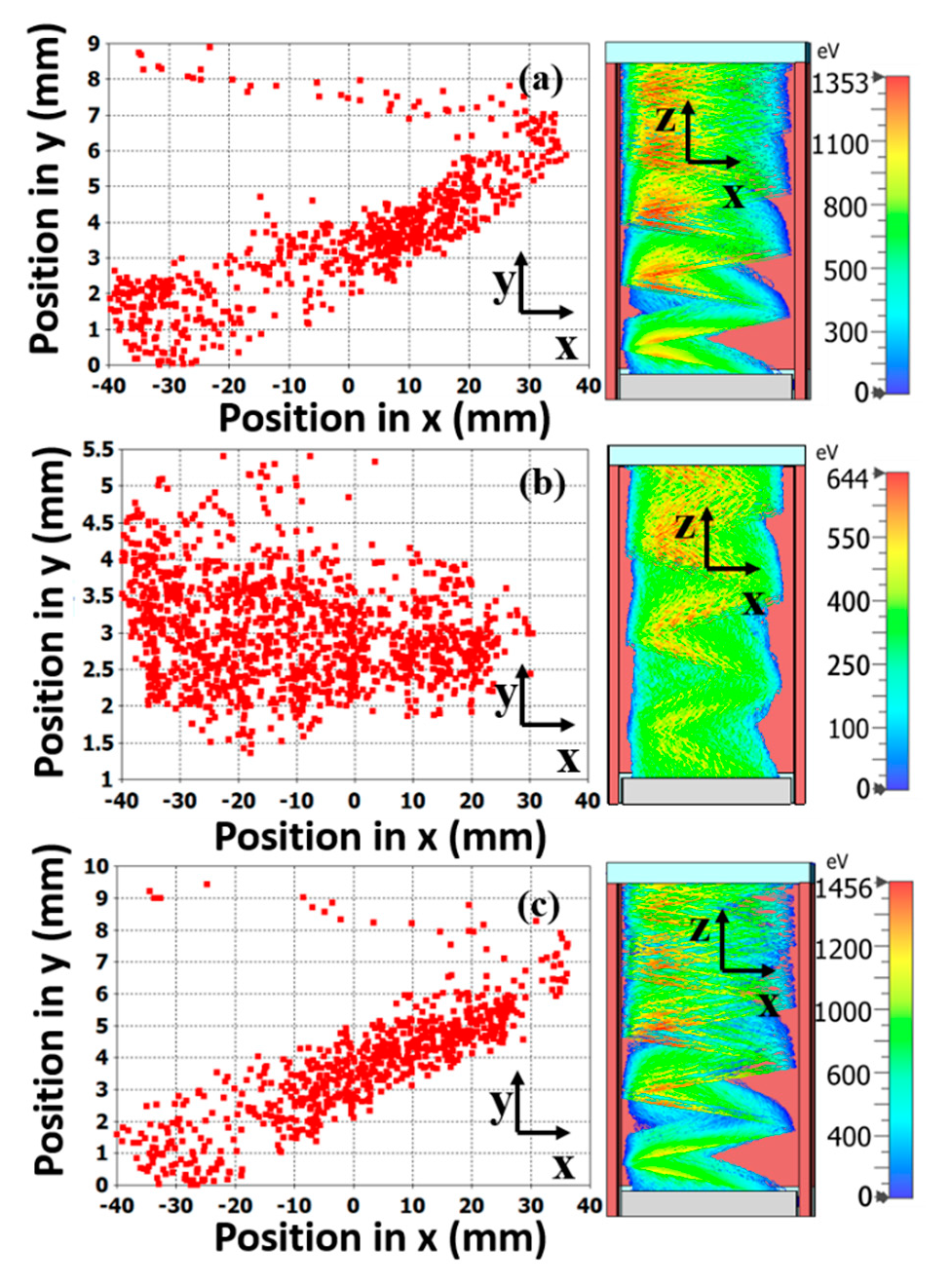
| Parameters | Value | Type of Study |
|---|---|---|
| Anode-Sole distance | 20 mm | Effect on minimum stable current density |
| Magnetic field | 0.01 to 0.05 T | Minimum magnetic field to insulate anode |
| Injected current | 1.5 mA to 1 A | Effects along with the operable range of current density on beam stability |
| Magnetic field tilt | 0° to 5° | Effect of tilted magnetic field on beam stability |
| Part | Applied Voltage | Injected Current |
|---|---|---|
| Sole | 0 V | |
| Anode | 3000 V | 1.5 mA to 1 A |
| Emitter | 200 V |
Publisher’s Note: MDPI stays neutral with regard to jurisdictional claims in published maps and institutional affiliations. |
© 2021 by the authors. Licensee MDPI, Basel, Switzerland. This article is an open access article distributed under the terms and conditions of the Creative Commons Attribution (CC BY) license (http://creativecommons.org/licenses/by/4.0/).
Share and Cite
Bhattacharya, R.; Darr, A.M.; Garner, A.L.; Browning, J. Analysis of Injected Electron Beam Propagation in a Planar Crossed-Field Gap. Appl. Sci. 2021, 11, 2540. https://doi.org/10.3390/app11062540
Bhattacharya R, Darr AM, Garner AL, Browning J. Analysis of Injected Electron Beam Propagation in a Planar Crossed-Field Gap. Applied Sciences. 2021; 11(6):2540. https://doi.org/10.3390/app11062540
Chicago/Turabian StyleBhattacharya, Ranajoy, Adam M. Darr, Allen L. Garner, and Jim Browning. 2021. "Analysis of Injected Electron Beam Propagation in a Planar Crossed-Field Gap" Applied Sciences 11, no. 6: 2540. https://doi.org/10.3390/app11062540
APA StyleBhattacharya, R., Darr, A. M., Garner, A. L., & Browning, J. (2021). Analysis of Injected Electron Beam Propagation in a Planar Crossed-Field Gap. Applied Sciences, 11(6), 2540. https://doi.org/10.3390/app11062540






